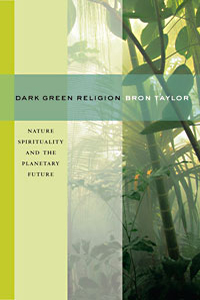DARK GREEN RELIGION:
NATURE SPIRITUALITY AND
THE PLANETARY FUTURE
Chapter 2. Dark Green Religion
(Listed In Order of Page and Paragraph Number In Dark Green Religion)
Dana Lyon’s song, The Tree, was discussed on pp. 27-28. More music by Lyons is found in his cows with guns website, provides access to additional music including that on an album to which Jane Goodall contributed, telling stories between the songs.
Marc Bekoff interview, which illustrates the way ethology (the study of animal consciousness and behavior) shapes animistic perception for some scientists.John Seed's website, and the organization he founded, the Rainforest Information Centre
James Lovelock website (includes links to video and podcasts)
Par. 2, on ‘worldview’: The term was coined in German originally in the 19th century as “weltanschauung” by Wilhelm Dilthey, ed., Dilthey's Philosophy of Existence: Introduction to Weltanschauungslehre (Westport, CT: Greenwood Press, 1978). It was and developed and made more sophisticated and useful for cross-cultural comparison by more than a century later, including by Ninian Smart, Dimensions of the Sacred: An Anatomy of the World's Beliefs (Berkeley, CA: University of California Press, 1966), Ninian Smart, Worldviews: Crosscultural Explorations of Human Beliefs (3rd Edition) (Upper Saddle River, NJ: Prentice Hall, 2000). The notion places a premium for understanding religion on apprehending beliefs, especially religious/metaphysical and ethical ones, and leads some scholars to pay insufficient attention to how systems of meaning and religious identities are enacted. Smart himself, however, linked such beliefs to other important dimensions of religious life, including its experiential, organizational, artistic, ritual, and political expressions.
Par. 2, on ideal types: It is important to remember that, with any typology, “map is not territory,” because the boundaries between them are fluid and fuzzy. The key question with regard to them is their utility: Do they have explanatory and heuristic power? The expression “map is not the territory” was coined by Eric Bell and popularized by Alfred Korzybski, and borrowed by J.Z. Smith as the title of his important book, Jonathan Z. Smith, Map Is Not Territory: Studies in the History of Religions (Chicago, Illinois: University of Chicago Press, 1978).Par. 2, unabridged Gary Snyder quote:
Eating is a sacrament. The grace we say clears our hearts and guides the children and welcomes the guest, all at the same time . . . To acknowledge that each of us at the table will eventually be part of the meal is not just being “realistic.” It is allowing the sacred to enter and accepting the sacramental aspect of our shaky temporary personal being . . . And if we do eat meat it is the life, the bounce, the swish, of a great alert being with keen ears and lovely eyes, with foursquare feet and a huge beating heart that we eat, let us not deceive ourselves. [Gary Snyder, The Practice of the Wild, 184, 19, 184.]Par. 2, Jane Goodall, the quotation related to ‘lingering afterward’: “I stayed in that place—it seemed a most sacred place—scribbling some notes, trying to describe what, so briefly, I had experienced. I had not been visited by the angels or other heavenly beings that characterize the visions of the great mystics or the saints, yet for all that I believe it truly was a mystical experience. [Goodall, Reason for Hope, 174.]
Par. 4, more from Goodall on respecting animal spirits:Goodall has suggested to meat eaters that, like indigenous people, they might “offer up a prayer for the spirit of the once living creature that has died for us” [Reason for Hope, 223.] Practicing such respect, as Goodall believes indigenous people do, “brings us back into communion with the natural world and the spiritual power that permeates all life while help us to move a little farther along the path of human moral and spiritual evolution” [Reason for Hope, 223.] During my interview with her she described a prayer ceremony for the forests around the world that she participated in with Chitcus, whom she called her Native American “spirit brother.” On one occasion, they visited an ancient tree on Oregon’s Mt. Hood that had been hollowed out by fire, which made it possible to see blue sky from inside the still-living tree. As Chitcus offered a blessing and “made smoke from the sacred Kish’wuf root,” Goodall “sent a prayer to God for the survival of the remaining forests of the world” [Goodall, Reason for Hope, 269.] During our interview she indicated that she then said, “You know this tree is taking the prayer right there for the world, up through the green, right up to the sky to the Great Spirit.”Although Goodall does not believe chimpanzees have a concept of life after death [Reason for Hope, 152], she does think they have the kind of ecstatic experiences in nature that may well resemble or be a precursor to religion. After describing behaviors she has witnessed at waterfalls and during thunderstorms, when chimpanzees seem to dance and sway rhythmically in ways that resemble religious ritual, Goodall commented,
Goodall suggests it is precisely this kind of naturalistic experience of “awe that gave rise to the first animistic religions [and] the worship of the elements,” see Goodall, Reason for Hope, 189.] She repeated and elaborated this line of thinking during our interview, “What triggers these displays are surely this kind of awe and wonder that we feel and early people you know, they must have been so amazed at thunder and lightning that this led to the animistic religions. And surely this would have led, this dancing would have become a ritual sort of the God of the waterfall you know? But without that spoken language each one has the emotion, the explanation for the emotion is trapped within.”
Par. 4, more on animal oracles:The anthropologist Robin Wright, when reading a draft of this chapter, reminded me of the Andaman Islanders who, after a massive earthquake off of Indonesia precipitated a tsunami, “were the first to flee to the hilltops because the behavior of the sea animals was giving a signal that the waves were coming.” This was a kind of naturalistic oracle based on the Islanders deep knowledge of animal behavior.
Par. 5, on Goodall’s religious eclecticism: In addition to Christianity, Goodall was familiar with and drawn to Theosophy, including its belief in reincarnation, as a teenager, which may help account for her receptivity to the spirituality of animals and the earth itself. [Reason for Hope, 32-34.] During my interview with her she spoke similarly about Theosophy, which suggested to me that it influenced her openness to spiritual experience and resistance to scientific reductionism.Par. 8, further evidence of Leopold’s biocentrism/ecocentrism:Other passages make clear the intrinsic value theory Leopold is promoting, including, “We have not land ethic yet, but we have at least drawn nearer to the point of admitting that birds should continue as a matter of biotic right, regardless of the presence or absence of economic advantage to us.” Leopold,Sand County, 210-11, also in Leopold, Sand County with Round River, 247. See also his assertion that the same point applies to “predatory mammals, raptorial birds, and fish-eating birds” (211 & 247, respectively) and even non-useful ecosystems (212 & 249, respectively). While Leopold was pragmatic such passages leave little doubt that his deepest ethical convictions were ecocentric, despite the efforts of the some environmental philosophers to paint him as an environmental pragmatist, as did Bryan G. Norton in Sustainability: A Philosophy of Adaptive Ecosystem Management (Chicago: University of Chicago Press, 2005).
Par. 4, more from Leopold about the ‘meaning known only to the mountain’:“Only the mountain has lived long enough to listen objectively to the howl of a wolf.” [Leopold, Sand County, 129, also in Leopold, Sand County with Round River, 137.]Par. 5., more examples of Gaian Naturalism: J. Baird Callicott, "Natural History as Natural Religion," in Encyclopedia of Religion and Nature, ed. Bron Taylor (London & New York: Continuum International, 2005). Of course, such spirituality is not entirely new, as shown in Ursulla Goodenough, "Religious Naturalism," in Encyclopedia of Religion and Nature, ed. Bron Taylor (London & New York: Continuum International, 2005), 1371-73. See also her book, Ursula Goodenough, The Sacred Depths of Nature (New York & Oxford: Oxford University Press, 1998). For examples that sometimes flirt with theism, see Loyal Rue, "Epic of Evolution," in Encyclopedia of Religion and Nature, ed. Bron Taylor (London & New York: Continuum International, 2005), Loyal Rue, Everybody's Story: Wising up to the Epic of Evolution (Albany, New York: State University of New York Press, 2000), and Swimme and Berry, Universe Story. See also Robert S. Corrington, "Deep Pantheism," Journal for the Study of Religion, Nature and Culture 1, no. 4 (2007), Donald Crosby, "A Case for Religion of Nature," Journal for the Study of Religion, Nature and Culture 1, no. 4 (2007), Donald Crosby, "Further Contributions to the Dialogue," Journal for the Study of Religion, Nature and Culture 1, no. 4 (2007).
Par. 5., reference exemplifying Lovelock’s environmental advocacy: James Lovelock, Healing Gaia: Practical Medicine for the Planet (New York: Harmony, 1991).

